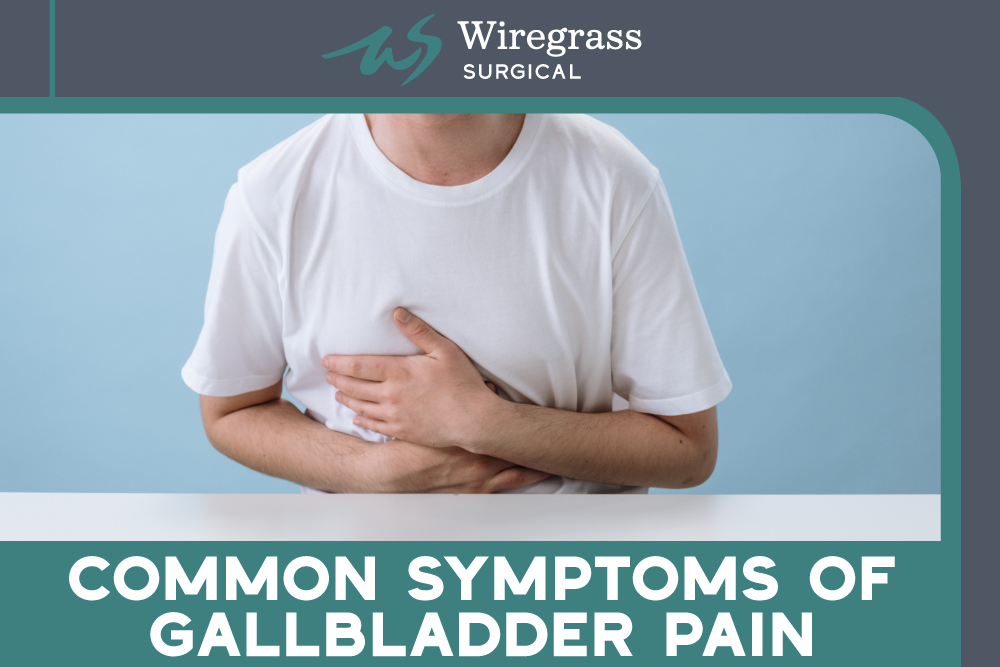
Common Symptoms of Gallbladder Pain
Many patients with gallbladder pain either present at the emergency room or are sent to Wiregrass Surgical Associates through their primary doctor. Either way, it’s smart to know the symptoms of gallbladder pain so you can be aware if/when a gallbladder attack hits!
What is your gallbladder?
Your gallbladder is a small, pear-shaped pouch tucked under your liver. It stores the fluid called bile that is produced by the liver. Bile breaks down fat and it is the gallbladder that sends bile through ducts to your small intestine to help you digest food after you eat.
What are symptoms of gallbladder pain?
About 80% of patients experience what we call “typical” gallbladder pain symptoms, while the other 20% may experience some type of “atypical” gallbladder pain symptom.
The typical gallbladder pain symptoms include:
- Pain under the rib cage or in the right upper quadrant of the abdomen, where the gallbladder is located
- Pain on the right side of abdomen or back pain
- Pain in the back usually beneath the right scapula or shoulder blade, or even in the mid-back area
- Nausea and vomiting
- Experiencing pain 15-45 minutes after eating foods high in fat, that lasts anywhere from 20 minutes to an hour
Many people realize that fried foods and foods with dairy (pizza, ice cream, etc.) can cause them pain or lead to a gallbladder attack. However, even foods with “good fat” such as avocados, nuts or olive oil can cause attacks as well.
Atypical pain symptoms include:
- No pain whatsoever, but nausea or nausea and vomiting alone
- Chest pain on the right lower side of chest can occur, but are usually accompanied with more typical symptoms of gallbladder pain
- Loose stools after eating
- Left-sided abdominal pain, usually below the left rib cage which can indicate a bad gallbladder. (However, this can be difficult to diagnose since most often pain is felt on the right side)
When bile can’t get in or out of the gallbladder, it causes symptoms of a gallbladder attack. Too much bile in the gallbladder is irritating and causes inflammation and pain. And backed-up bile can enter the bloodstream causing your skin and whites of the eyes to turn yellow (jaundice). You may also notice you have fever/chills, darker colored urine and/or lighter colored stools.
What are gallstones?
When too much cholesterol or bilirubin are in your bile, crystals start to form. These can clump together and form stones which can be as small as a grain of sand or as large as a golf ball. They usually aren’t an issue unless they get stuck in your bile ducts and block the bile from leaving. They are the most common cause of gallbladder pain.
How to remove the gallbladder
Our general surgeons are highly trained to perform cholecystectomies, which is the surgical removal of gallbladders. It is a common surgery and most patients can go home the same day. It is usually performed to treat gallstones and your doctor may recommend a cholecystectomy if you have:
- Cholelithiasis: gallstones in the gallbladder
- Choledocholithiasis: gallstones in the bile duct
- Cholecystitis: gallbladder inflammation
- Large gallbladder polyps
- Pancreas inflammation due to gallstones
Our general surgeons can perform these laparoscopically, or in some cases you may need an open cholecystectomy, or one large incision to remove the gallbladder.
Minimally invasive/laparoscopic cholecystectomy
During the laparoscopic cholecystectomy, the general surgeon will make four small incisions in your abdomen. A tiny video camera will be inserted through an incision and the surgeon will watch the video monitor while using surgical tools inserted through the other incisions to remove your gallbladder. You may need an x-ray or ultrasound if they are concerned about gallstones or problems with your bile duct. Once completed, your incisions are sutured and you are taken to the recovery area. The procedure takes anywhere from 1-2 hours. If you have had previous abdominal surgery, or have scar tissue at all, your surgeon may recommend the traditional, or open cholecystectomy instead of a minimally invasive approach.
Traditional/open cholecystectomy
In this procedure the surgeon will make a 6-inch incision in your abdomen on the right side below your ribs. Muscle and tissue will be pulled back to remove the gallbladder and the incision will be sutured when completed. An open cholecystectomy takes 1-2 hours.
Depending on your procedure, it may take 1-4 weeks to recover. Patients who undergo laparoscopic cholecystectomies may be able to go back to work in a matter of days, while those with an open cholecystectomy may need a week or more to recover.
The goal of our surgeons is to always do what is best for our patients– the method that is the safest, has the fastest recovery time, smallest incisions and is the overall best fit for the patient. Our robotic surgery experience provides our patients with a decreased operating time, hospital stay and post-operative pain, which is why our patients love what we do.
Learn more about robotic surgery and 5 benefits of it.
